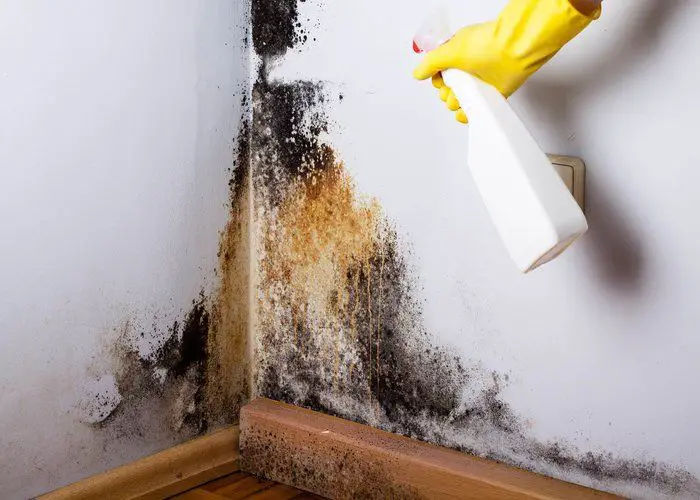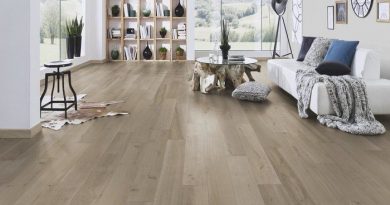How to Remove Mold from Wood
Mold can develop on a lot of surfaces in the house. If it can attack your walls, it can also form on wooden furniture that it can destroy in time. To save your pieces of furniture made of natural wood from mold, but also to protect your health, find out how to remove mold from wood!
What is mold and why does it appear on the wood?
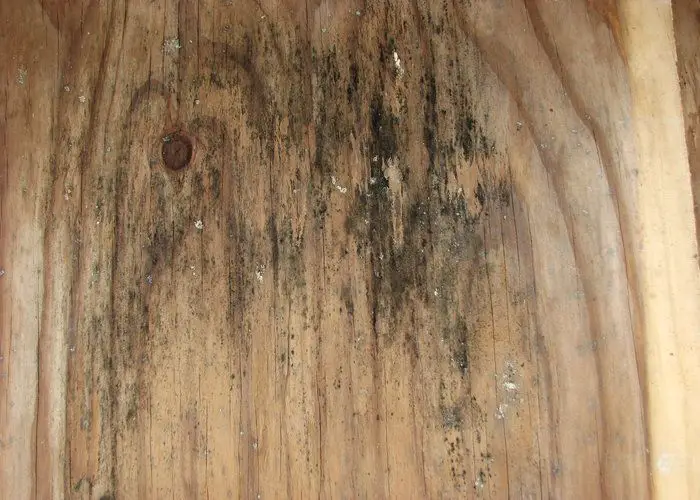
The mold is made up of microscopic mushrooms that multiply by spores and appear in areas with high humidity.
The high humidity will favor both the appearance of the mold and its development.
Indoor mold is different from the mold present in food, and the most common types of indoor mold are Penicillium, Cladosporium, Alternaria and Aspergillus.
Mold can appear both inside a home and outside. Mold spores enter the house by air, but also by heating and ventilation systems.
The surfaces that can be most affected by mold are the kitchen, the bathroom and the balcony, but they can appear in other rooms, if you have problems with the water seepage from outside the house or in the apartment.
Mold appears and develops also on wooden surfaces, it can break down paints or adhesives and that is why you can often find mold on the walls of the house
The main factors that favor the appearance and development of the mold are moisture, heat and lack of adequate insulation.
- a warm and humid environment : the humidity and the heat from the inside favors the appearance of the mold especially in the cold season, due to the large temperature differences
- condensation formation : incorrect insulation of the walls will block the transfer of moisture from the inside to the outside and thus the condensate will form, conducive environment for mold development.
- water infiltration : if the waterproofing is done with poor quality materials, water infiltration can occur in the interior walls of the house.
It is recommended that these works be performed by a professional, to avoid the appearance of mold in time
Types of mold:
White mold – is the most common and forms as a dense white patch that covers the surface.
It is easy to recognize precisely because of the white color and the appearance of white-gray wool.
Aspergillus – is a green mold and is very common in nature – on corn, nuts or straw – but also on the surface of foods such as bread or potatoes
Cladosporium – has a dark green color and appears on textiles or wood surfaces.
Penicillium – can be green, as well as alabaster or blue and usually appears either on fruits and vegetables or on surfaces in the home – walls, wallpaper, carpets, basement corners.
Alternaria – is the one type of fungi that causes brown spots on the leaves and fruits
Stachybotrys – a black-green color, this type of fungi appears more often on wood or gypsum panels
How do we detect mold in places where it is not visible?
Mold is hard to detect because it can also be formed in places out of sight: after large furniture objects, for example.
It is possible to have mold under the parquet, in case you do not see it, but it can affect your health, as well as the one from visible places.
You can realize that there is mold in your house if you feel a specific smell of moisture.
The smell of mold resembles that of moist soil. If you spend a lot of time at home, there is a chance you will not feel it.
However, if you return home after spending some time away, you smell this smell, but do not find the place where it formed, you should investigate its source. If you do not see it behind the furniture items, you should also check the floor.
Want to know if wood is rotten? I will show you an easy guide how you can detect if wood is rotten!
How to Remove Mold from Wood
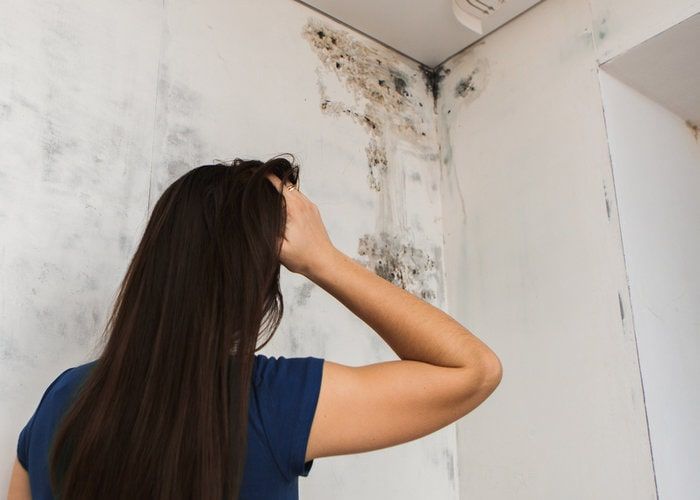
Removing mold from wood furniture is not difficult, but it is important to intervene as quickly as possible before the spores penetrate the wood and destroy your furniture.
Here’s what you need to do to remove mold from wood:
Mold is formed in dark and humid areas.
In case your furniture is placed in a room with high humidity, poorly ventilated, in which the natural light does not penetrate enough, it may be necessary to remove it from this space that predisposes to mold formation.
Arm yourself with gloves and a face mask to prevent inhalation of mold spores during the process of removing the mold.
Also, if you use bleach when you remove the mold from the wood furniture, gloves and mask are also recommended in this situation.
HOW TO REMOVE MOLD FROM WOOD – METHOD # 1
An efficient mold removal solution on wood furniture is made of water and detergent.
- In a bucket, add 4 liters of hot water and about 50 grams of laundry detergent.
- Soak a clean, soft cloth in the solution obtained and wipe the affected surfaces.
- In order not to spread the mold spores in the atmosphere, you can spray the water, in advance, on the surface to be cleaned.
- Finally, mix 250 ml of water with 1 teaspoon of bleach, soak a cloth in the solution obtained and wipe the surface of the previously sanitized furniture.
This way, you make sure that the mold has been completely removed.
After cleaning the mold furniture, the room must be thoroughly ventilated so that the wood dries as quickly as possible.
For even more efficiency, if the odor of the mold persists in the air of the room, introduce deodorants in the room that will catch the invisible spores of the mold and will spread a pleasant fragrance.
5 Simple Solutions to Remove Mold from Wood
Fortunately, mold can be removed from wood with only a little effort and with the right solutions.
Mold is something that a lot of people have to cope with and remove from their homes. Discover the most effective and most natural ways to get rid of it.
Before applying any of these methods, equip yourself with gloves and a protective mask to minimize the possibility of getting in touch with micro spores.
HOW TO REMOVE MOLD FROM WOOD – METHOD #1
Sunlight
We have already established that mold needs moisture and darkness to grow, so it’s no wonder that sunlight can do wonders to remove the mold from wood.
The method works only for mild infestations and can only be applied to objects that can be removed outdoors (so it won’t be helpful if you have mold on the walls).
If you have the necessary space and if the weather is hot and dry, try removing furniture, carpets or other textile items outside.
Leave them for two to three days in the sunlight and air.
HOW TO REMOVE MOLD FROM WOOD – METHOD #2
Sodium bicarbonate
In the unlikely event that you don’t already have a sachet of baking soda somewhere in the house, you can buy one from almost any grocery store.

You can either mix in approximate quantities the bicarbonate with water and spray over the affected areas of the mold, or you can directly place the bicarbonate granules over the mold, if the infestation has formed only on a horizontal surface.
The method is efficient at removing mold for cleaning the wood,walls, carpets and other textile materials.
If you spray the bicarbonate solution over the mold, you will need to do this at least twice, to be sure the fungi have been removed.
HOW TO REMOVE MOLD FROM WOOD – METHOD #3
Vinegar
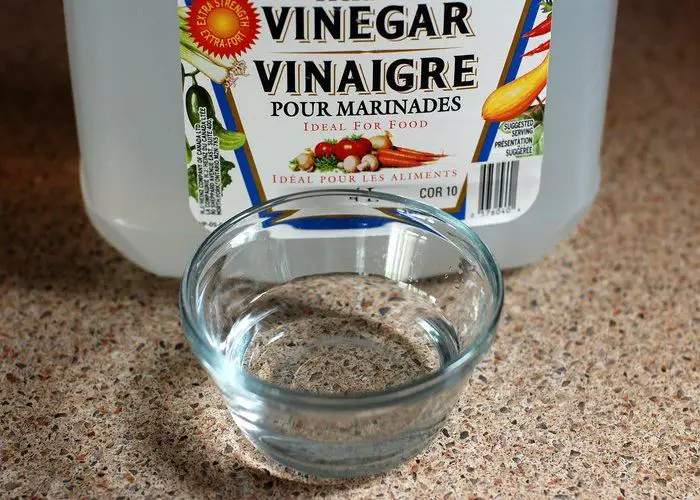
One of the most popular solutions to remove mold from wood is white vinegar. Even if it does not kill any type of mold, it is a cheap, natural solution that you can apply on any surface and material.
The simplest solution you can make contains half water and half vinegar.
If you want to increase the efficiency of the solution, you can add two tablespoons of baking soda and the juice of a squeezed lemon.
This is probably the most powerful natural anti-mold solution you can make at home.
HOW TO REMOVE MOLD FROM WOOD – METHOD #4
Chlorine
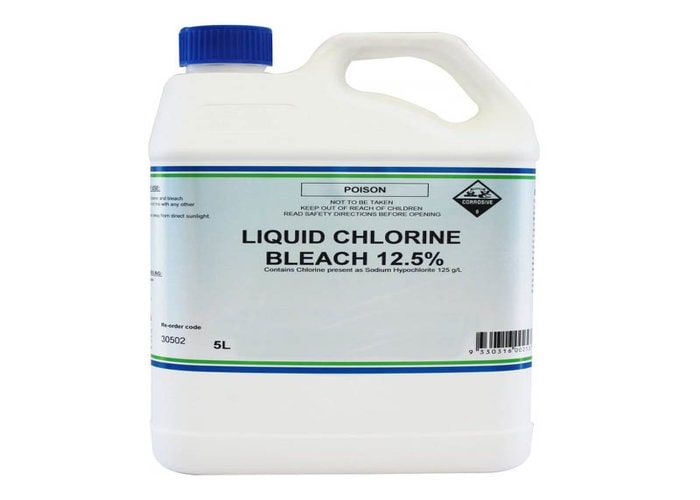
If none of the above solutions work, you only have to mix a few measures of chlorine in a water-filled basin and clean the mold until it disappears.
Chlorine can be used to remove strong mold from any surface including wood. However, there is a risk that the substance will discolor textiles or stain furniture.
If none of the above solutions help you remove mold, it means that the infestation is much deeper than it seems.
You will need to purchase special mold cleaning products or call on professional disinfection companies.
You also have to consider that, in rare cases, the infestation can be so strong that you will only be able to repair the plaster of a wall or throw away furniture or textiles affected by mold.
If you want to know how to remove mold from wood and you no longer want to use chemicals, I invite you to discover below the most effective natural method of removing mold from wood!
HOW TO REMOVE MOLD FROM WOOD – METHOD #5
Hydrogen peroxide is another great way to get rid of the mold from wood.
Combine a half a cup of this liquid with a cup of warm water. Spray it on to the area and let it sit for ten minutes before you scrub it down.
You will need:
- 100 ml of apple cider vinegar
- 100 ml of water
- 10 ml of hydrogen peroxide
- Lemon juice
- 2 tablespoons baking soda
Method of preparation:
Mix all the ingredients in a bowl, then add them to a spray container.
Before starting the procedure, be sure to open the jams, do this to circulate the air.
To remove mold from wood, all you have to do is spray this mixture abundantly over the areas covered with mold.
Leave on for about 3-4 hours, after which, with the help of a cloth, you can rub to remove mold from wood.
By doing this, you will get rid of mold from wood from the first application!
Tea Tree Oil
This is one in all, the most competent methods remove mold from wood, which eliminate spores that are discharged through the house.
It’s natural antimicrobial attributes that assists to disinfect the region and make it easier for people that are allergic to it to breathe easier.
Combine a teaspoon of the oil with two cups of water. Spray it onto the infected area and permit it to dry. The odor from the oil is kind of strong – but it’ll dissipate after some days.
How to Remove Mold From Garden Wood Furniture
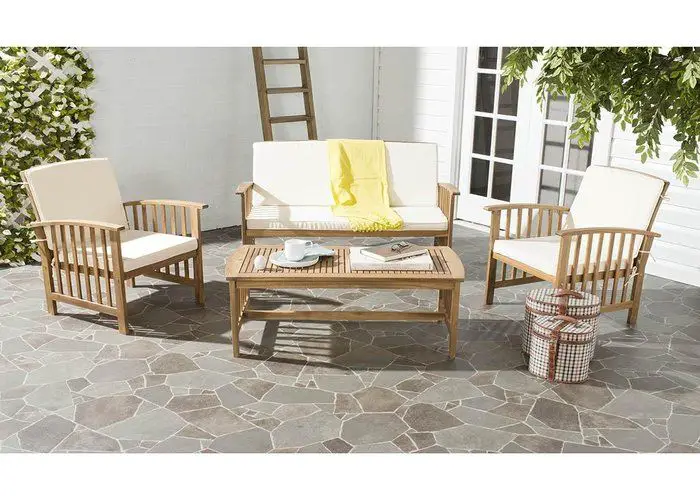
The green areas with mold that appear on your garden furniture are not attractive and do not turn your terrace into the most attractive place.
Once the green spores have attacked your garden furniture, you need to use mold cleaning solutions and work hard to counter their attack.
MOLD AND MUSHROOMS INFORMATION:
They emit microscopic spores into the air that help spread them. They multiply in shady, humid and warm environments.
The cold and dry weather does not annihilate the mold, but slows down their growth process.
It is enough to frequently use water and a hard brush to remove deposits from garden furniture.
If the fungus or mold has attacked your garden wood furniture, you should not leave the furniture outside in the winter, in the hope that the cold weather will remove them.
The cold will only keep the growth of spores under control until the heat and humidity will ensure perfect growing conditions.
So, you should store your furniture in a shed or garage during the winter. This will also prevent unnecessary damage to the furniture.
How to Remove Mold From Garden Furniture
To remove mold from garden furniture you need a hard brush and water. If you fail to clean them you can add vinegar to the treatment.
The mixture must contain vinegar and water. Make sure that you clean all the furniture, not only the attacked parts, because the invisible spores of the algae can spread on all the furniture.
Remember to clean all the corners and cracks with the solution against mold and fungi, otherwise they will reappear soon.
CHEMICAL TREATMENT AGAINST MOLD
If the mold is still damaging your furniture, and the mixture of water and vinegar has not been shown to be effective, you can take more drastic measures.
There are several types of cleaning solutions that can remove fungi and mold from wood furniture in 1-2 weeks. Another advantage of these solutions is that of surface protection and prevention of new deposits.
SAME TREATMENT AGAINST WOOD AND PLASTIC MOLD
Regardless of the material of your garden furniture, the treatment against mold is the same.
However, plastic garden furniture can withstand mold removal methods better than wood, which you need to be careful about if you use a hard brush or pressure washer.
If you choose to remove deposits with a pressure washer, keep a safe distance so that you do not damage the furniture and create irregularities that will facilitate the installation of algae.
AFTER MOLD TREATMENT
Solid wood furniture must be treated with oil, but it must be completely dry before applying the treatment and a suitable oil must be used.
It is recommended to apply an oil treatment two or three times during the season. Teak wood furniture does not require oil treatment, because teak is already a fairly oily wood.
Over time, teak wood furniture takes on a natural white tint that can be removed with teak oil.
If you decide to apply an oil treatment to your furniture, you will need a continuous treatment as in the case of solid wood furniture.
FIND OUT THE SOURCE OF THE APPEARANCE OF THE MOLD
The environment in which the garden furniture is located must be part of the treatment against mold.
If the problem is big, you need to find out where the deposits come from, because you can prevent the problem and stop their development.
Although large trees provide shade, they transmit algae spores to the terrace and garden furniture.
So, you have to think about whether it’s better not to keep your garden furniture away from trees.
Leaks from gutters and downspouts can also lead to increased moisture around garden furniture, providing favorable conditions for mold development.
HOW OFTEN DO YOU NEED TREATMENT AGAINST MOLD?
Mold and fungi on the wooden garden furniture can cause it to rot, due to their moisture.
Therefore, you must be careful about their development if you want to keep your garden furniture beautiful.
Once they have found an incubation place, they will spread a little each day through spores. Therefore, it is important to be careful about their development and to be one step ahead.
The mold should be removed from the garden furniture every spring and autumn when it has the perfect conditions for development in wet weather.
How to prevent mold formation on wood
Prevention is much more effective than treating wood furniture affected by mold.
To prevent any problems, here’s what you should know:
- The furniture, but also any other wooden objects in the house must be kept permanently dry, in order not to create the environment conducive to mold development.
- In rooms with high humidity, use a dehumidifier. This will regulate the humidity level and prevent the formation of mold. Frequent ventilation of the rooms is also recommended.
- In case of a flood or any other incident that causes the wood furniture to damp, allow it to dry as quickly as possible.
- Don’t forget to take care of the wooden furniture on the terrace or even in the backyard of the house, protecting them from the excessive humidity during the spring and autumn.
An effective way to protect wood surfaces is to apply a waterproofing solution.
Here is a simple and effective method how you can protect your wooden furniture!
How can you prevent the appearance of mold
The best solution against mold is its prevention. The mold is not neglected and you must do everything possible to prevent its occurrence in the home.
There are a few simple methods by which you can keep your mold away from your home:
- ventilate the rooms: it is advisable to ventilate the rooms at least twice a day to eliminate the moisture accumulated inside the house. The bath is one of the places predisposed to the appearance of mold due to the increased humidity, so after each shower it is advisable to leave the window open or, as the case may be, to start the ventilation for a few minutes.
- controls humidity: humidity can be controlled using a room hygrometer that indicates the humidity level. The recommended humidity value should be between 30% and 50%, lower in summer and higher in winter. You can keep humidity under control and at the same time to surround your home with plants that absorb moisture: fern, ivy or chamaedorea (dwarf palm).
- waterproofing: if waterproofing is done correctly, it can prevent mold from appearing inside the home. There are many types of materials that are used for waterproofing and it is recommended that this be done by a specialist so as to remove the problem of water infiltration through the walls.
- do not dry the laundry inside: evaporation of water inside the house will increase the humidity level. It is advisable to dry the laundry in an open or well-ventilated space
- use anti-mold paint: a handy solution is anti-mold paint that can be used in rooms with high humidity. If you have the opportunity to decorate your home alone or renovate it, you can use this paint to prevent mold formation.
- frozen sticks: a modern solution against mold is the use of these frozen sticks.
How are you doing? You must make holes in the wood, at a distance of 11 cm, as close to the foundation of the house.
The depth of the holes must be smaller than the thickness of the walls by 2.5 cm. You must first insert the rods into the freezer, then into the holes in the wall.
After melting the first row of sticks, you must repeat this operation three more times, then you can plaster the wall. The treatment life is 25 years.
Electro-cyber solution is the latest trend in mold prevention. The electro-cyber system is composed of an apparatus that is mounted on the wall of the room, with four screws.
Through long-wave electromagnetic impulses, this device extends the fatigue over a radius of 12 m. The device has a low energy consumption and is effective in preventing mold for 20 years.
CONCLUSION
Using one the of the above methods you will know how to remove mold from wood.
Wood treatment is one of the best ways to keep mold and other wood pests at bay. This treatment is performed with special solutions that remove all mold spores from wood.
The decision to control mold depends on several factors. In general, surfaces where mold is visible must be cleaned and people come in contact with it.

